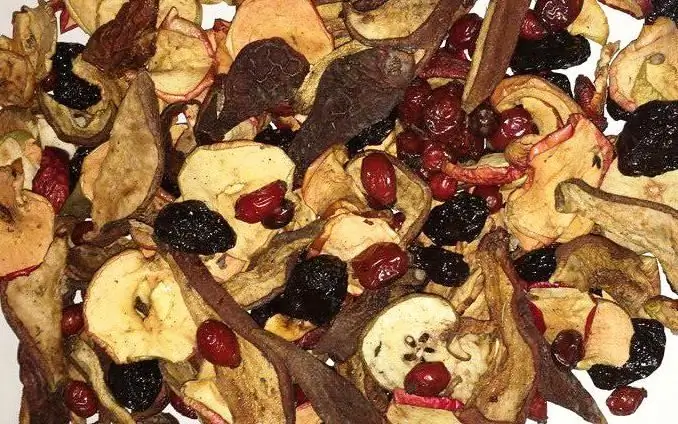2025 Author: Isabella Gilson | [email protected]. Last modified: 2025-01-23 12:50:39
Adjika is a fragrant symphony of oriental spices with a sharp character. It is difficult to find a more perfect combination of fragrant herbs, hot pepper and nut paste. This product is actively used to flavor meat, is added to numerous soups and serves as a great addition to various dishes.
What is Abkhaz adjika made of

The very name "adjika" came to us from the Abkhazian language and in translation means ordinary s alt. Despite the fact that the Abkhazian adjika comes in different colors, the base of all species remains unchanged. S alt, garlic and red hot pepper are the main ingredients. The color of the seasoning depends on the composition of herbs and dried herbs, ground in a special way.
From orange and red adjika, after grinding with walnuts, walnut oil was squeezed out, which was later used for processing meat, marinating poultry, dressing vegetables.
Technology for making classic Abkhazian seasoning

According to ancient tradition, real adjika is cooked on a flat stone, which has a slight wear in the center. The counterpart, which is crushedingredients, also stone, but smaller. The grinding stone is pressed with the left hand from above, and with the right hand, circular movements are carried out. With the help of such a device, the Abkhazians also rubbed walnuts, roots or chestnuts.
Using stone grinding allows you to make adjika with a very thin consistency, similar to butter. Therefore, sometimes you want to call this product “Caucasian oil”. Abkhazians use adjika with almost any food and cannot imagine life without this magical condiment.
Unfortunately, at the present time there are many fakes that have nothing to do with the classic Abkhazian adjika. Beautiful labels can mislead even a real gourmet. Especially strange are the inscriptions that adjika is made somewhere in the Moscow region, or the composition of adjika contains tomato paste. But the most offensive is the fact that the origin of this magnificent product is attributed to Georgian cuisine, mistakenly assuming that it was they who created the perfect recipe for a seasoning with an Abkhazian name.
Secret ingredients of Abkhaz adjika, composition, recipe

Adjika can be conditionally divided into two types: burning red and green. The red color of the seasoning is given by hot peppers, and not by tomatoes, which are generally absent in the recipe. The recipe uses 500 g of dried capsicum. To restore its natural moisture, the product is placed in a container with warm water, pressed down with a load and left for three hours.
Then the liquid is drained and softenedthe pods are rubbed on a stone surface along with the rest of the spices, namely with all the remaining ingredients that make up the adjika: with a head of garlic, coriander, savory and dill seeds taken in an amount of 10 g each. Some housewives pass the mixture through a meat grinder, but such grinding does not allow the essential oils contained in the seeds to stand out and provide the seasoning's signature aroma. Therefore, use classic technology whenever possible.
To maintain the necessary viscosity of aromatic puree, grated walnuts are added to the mixture, approximately 100 gr. Nut butter will provide the product with a creamy taste. Also add s alt to adjika to taste. Seasoning is stored in a glass jar for quite a long time, and this does not require a refrigerator at all.
Green adjika is prepared similarly to red, with the only difference being that the pepper is taken green. Mint, cilantro, and basil are added as fresh herbs for added flavor. S alt in the seasoning is also present in reasonable amounts. Oddly enough, such a green composition of adjika is no less popular among Abkhazians. In the Caucasus, it is even consumed with dairy products.
Adjika with Georgian flavor

Despite the assertion that Georgian adjika does not exist, there are still recipes that closely resemble this product. In Georgia, walnuts are very fond of, and therefore they are present in almost all dishes. Adjika is no exception. The composition of the Georgian adjika is very similar to the Abkhazian, butthe mass fraction of nut paste in it significantly exceeds the norm. In addition, the greens that are added to the pasta are not ground, but cut into small pieces with a knife.
Walnuts, before they are ground into adjika, are dried in the oven or in a frying pan. Then they are cleaned of thin husks and only then they are ground.
Russian variants of Caucasian adjika
As noted above, the composition of Abkhazian adjika does not contain tomatoes familiar to us. But while the recipe has come down to us, it has changed a little. Naturally, the classic taste was partially lost, but due to the introduction of new ingredients, the dish received a new flavor. Consider a few of these recipes.
Ajika in Russian

To prepare the seasoning, you will need 800 g of fresh capsicum, five heads of garlic, 125 g of coarse s alt, half a glass of mixed spices (suneli hops, dill, cilantro).
To work with such ingredients, you will need rubber gloves, as the skin on the hands can suffer from hot peppers. If the amount of red pepper seems large, then it can be partially replaced with sweet paprika or tomato paste.
All prepared products must be passed through a meat grinder and mixed well. You can use a blender to grind. The resulting paste does not need to be subjected to heat treatment. Just spread the mass in glass containers and store.
As you can see, the composition of homemade adjika is slightly different from the classics, but it also has the right to exist.
Adjika sfuck

As you know, horseradish has a certain pungency and is an excellent preservative. The composition of adjika with the addition of horseradish will look like this:
bell pepper and hot pepper - 6 each;
4 tomatoes;
medium horseradish root;
· s alt in a reasonable dose;
parsley, dill and coriander seeds;
garlic 1 head.
Judging by the bouquet of ingredients, the result will be quite hot, so the consumption of such adjika will be minimal. Although many gourmets are able to use such a mixture with spoons.
Tomatoes and peppers need to be peeled and turned through a meat grinder, seeds can not be removed. Horseradish root should be grated on a coarse grater. Garlic can also be grated or it is easier to add it to the tomato mass in a meat grinder. Greens are cut into small fractions and added to the mixture. At the end, the pasta is s alted and laid out in jars.
As you can see from the above examples, everyone has their own adjika. The composition and preparation are very different, therefore, when looking for a classic seasoning, it is more correct to turn to Abkhaz culinary specialists.
Recommended:
Cod fish: benefits and harms, calories, composition of vitamins and minerals, nutritional value and chemical composition. How to cook delicious cod

This article will tell you about what is included in the chemical composition of cod, what benefits it brings to human he alth, and also in what cases it should not be consumed. There will also be presented several recipes for cooking cod in the oven, in a pan, in the form of fish soup, etc
Compote mixture: composition, taste and method of compote preparation

Compote mixture is seasonal fruits dried in an oven or in an electric dryer, from which housewives cook compote in summer. Such blanks are very convenient to use, stored all year round. If you dry your favorite apples, plums, pears, apricots or peaches on your own in the summer, you can cook delicious and fragrant compotes all winter and spring
Coffee latte: composition, types, ingredients and nuances of preparation

Lots of people love coffee drinks. Moreover, they can differ in a variety of composition. Latte coffee originated in Italy, they drink it there in the morning. Today it is popular all over the world. Read more about the composition of latte and its preparation in the article
Borscht: composition and preparation

Every self-respecting housewife will tell you without hesitation how to cook this dish, which in most cases is a kind of thick beet-based soup, and it is this root vegetable that gives the authentic dish a characteristic red-brown color scheme. In addition, of course, the composition of borscht includes many other ingredients, with varying degrees of certainty in various recipes around the world
French coffee: description, composition and preparation features

Historical excursion to the coffee traditions of France. Recipe for classic coffee with cognac. Using vanilla to give a special coffee flavor. Subtleties and secrets in making coffee

